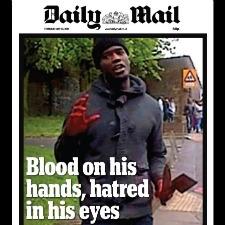BOB GARFIELD: From WNYC in New York this is On the Media. Brooke Gladstone is out this week. I’m Bob Garfield.
On Thursday, one of the suspects in the grisly Woolwich, England murder of Soldier Lee Rigby was formally charged. The broad daylight killing last week was crude and bloody, but perhaps more shocking than the crime itself was the terror suspect’s invitation to a crowd of horrified witnesses to video him declaring his jihadist motivations.
MURDER SUSPECT: The only reason we have killed this man today is because M – Muslims are dying daily by British soldiers, and this British soldier is one – is a eye for a eye and a tooth for a tooth.
BOB GARFIELD: We could have played more of this, but that’ll do. Suffice to say the man grasped a knife and a cleaver in his blood-smeared hands as he ranted into one or more cell phone cameras. In the background, crumpled onto the street was Rigby’s body. It was all aftermath. The crime itself was not photographed, but as Alfred Hitchcock well understood, in video the mind fills in the blanks, amplifying, not softening the horror. The blood and the blades spoke ghastly volumes, and in the ensuing week TV channels in Britain and the British Press Complaints Commission received hundreds of objections to the images of the Woolwich suspect that were endlessly displayed in the coverage of the attack.
All British newspapers used the images online and off. On television, ITV news and the BBC both showed footage of the bloody diatribe. Only Sky News refrained from airing it because the editors said it was too distressing.
Yes, according to the physician-patient relationship that governs much serious journalism, Sky News decided first to do no harm. This was forensic psychiatrist Park Dietz speaking after a mass shooting in Germany in 2009.
DR. PARK DIETZ: If you don’t want to propagate more mass murders, don’t start the story with sirens blaring.
BOB GARFIELD: At the time, the Guardian’s press critic Charlie Brooker intercut the psychiatrist’s advice with contemporaneous examples of the British press ignoring the best practices at every turn.
[CLIPS]:
DR. PARK DIETZ: Don’t have photographs of the killer.
FEMALE CORRESPONDENT: The 17-year-olds three-hour rampage ended in his own death.
DR. PARK DIETZ: Don't make this 24/7 coverage.
FEMALE CORRESPONDENT: The German chancellor is about to give her reaction. We’ll bring that to you live.
DR. PARK DIETZ: Do everything you can to make a body count the lead story.
MALE CORRESPONDENT: Carnage in the classroom, 16 people are dead.
DR. PARK DIETZ: - not to make the killer some kind of anti-hero.
MALE CORRESPONDENT: Dressed in black combat gear, the government opened fire at random.
[END CLIPS]
BOB GARFIELD: Four years later, it’s an easy stunt to reproduce.
MALE CORRESPONDENT: Two men got out of the car and carried out a savage attack.
FEMALE CORRESPONDENT: - the two men hacking at the victim with a knife.
MALE CORRESPONDENT: The men told witnesses their savage attack was an attempt to start a war on the streets.
BOB GARFIELD: There would seem to be powerful conflicting interests at play. On the one hand is the public's right to know. A terror incident is a terror incident and if the media are physicians they're not nannies sweetening medicine to make it more easily go down.
On the other hand, there are genuine risks to sensationalizing coverage. First, there is the competitive impulse to exploit the horror and the victims for more titillation than illumination, which degrades the media and audience alike. More ominous is the likelihood of encouraging copycats and other attention seekers to commit similar atrocities for the very purpose of dominating the news. Terrorism is, after all, about creating terror. And terror cannot spread in a publicity vacuum nor, by the way, can violent reaction.
In England, some combination of the murder and the 24/7 repetition of the murder suspect’s video defiance triggered street violence by the ultra-right nationalists the English Defence League –
[SOUND OF CHANTING]
MAN: Islam is not a religion for the peace. Islam is fascist and it’s violent, and we’ve had enough!
BOB GARFIELD: And individual expressions of rabid racism and xenophobia, like this woman on YouTube:
[YOUTUBE CLIP]:
WOMAN: This is our [BLEEP] country. We [BLEEP] belong here. Them [BLEEP] don’t! It’s about time you all got [BLEEP] back where you come from.
[END CLIP]
BOB GARFIELD: Let's assume those sentiments were simmering long before Woolwich, but let's also think about what brought them to full boil, a relentless video loop assaulting the psyche of a nation. Now, that's not an argument for suppressing news, but it is an argument for proportion and perspective, for being circumspect, as opposed to hysterical. And it can be done.
In fact, due to a wrinkle of British law called sub judice, media there are forbidden to print or air anything which could prejudice the proceedings of an act of criminal investigation or trial.
[MUSIC UP AND UNDER]
A piece of the Woolwich suspect’s bloody tirade, in fact, the very part we played in the beginning, was explicitly self-incriminating, so that part of the British press simply didn't play.
[MUSIC/MUSIC UP & UNDER]
